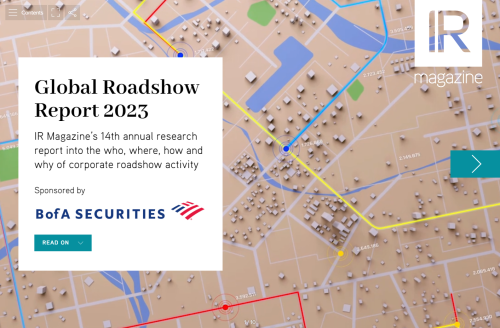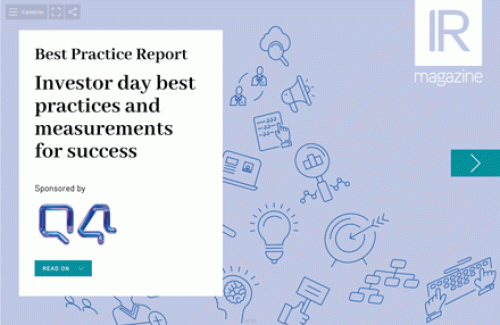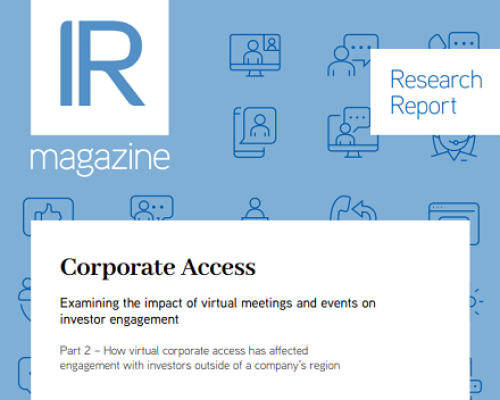Beyond counting roadshows and meetings, how can you assess your roadshow program?
On the road again: as experienced IROs know, taking your story to the street is part of the job. Nine out of 10 companies go on a roadshow at least once a year, according to the latest IR Magazine Global Roadshow Report. That figure is pretty consistent across North America, Europe and Asia. On average, firms participate in eight roadshows a year, with European companies reporting slightly higher activity, and other parts of the world slightly lower.
Ipreo’s fourth annual Global Corporate Access Survey finds the number of one-on-one meetings has dropped from an average of 116 per issuer a year ago to 108 in 2013 among 450 respondents across all market caps and geographies. That overall trend is driven by continued declines at small-cap companies, while both mid-cap and large-cap companies saw upticks in 2013 after a dip the previous year.
‘Suitability of investor meetings’ is the top success factor for IROs in the Ipreo survey, with 77 percent of respondents scoring it as ‘extremely’ or ‘very’ important, while they score ‘quality of research’ at 67 percent.
Made to measure
It’s easy to count how many times you hit the road, but can you tell whether all that effort is working? How do you know whether a meeting went well? Can you demonstrate to your CEO and CFO that going to a conference or a non-deal roadshow is a good use of their time as well as yours? Simply put, how do you measure the success of roadshows?
A natural and inherent conflict of interest exists in the non-deal roadshow or conference environment. A sponsoring broker is incentivized to serve its highest-volume (and highest-commission) trading clients by putting company management in front of just the sort of investors IROs dread: high-turnover, trading-oriented hedge funds. Savvy IROs have become skilled at navigating that dynamic, taking greater control of the itinerary while still playing ball by agreeing to set aside meetings for some broker clients. But the question remains: how to measure effectiveness?
‘IR has always been part science and part art,’ observes James Tickner, head of investor targeting in the corporate solutions business at NASDAQ OMX, which came out of the Thomson acquisition last year. ‘It’s definitely a balancing act,’ he adds, because IROs are faced with the challenge of managing the sell side’s growing demand for management access while ‘extracting value’ from the broker relationship that also serves the company’s interests.
While an IRO can look back to see how ownership moves over time, Tickner says qualitative inputs are still ‘the driving force’ in evaluating roadshow effectiveness. Best practice extends beyond just tracking ownership or counting the number of meetings, he argues. IROs should instead focus on ‘quality of access’. Were the highest-priority targets given one-on-one management access? Did high-turnover or less important investors get covered more efficiently in group settings?
He also advises IROs to pay attention to misfires, where a target fund seems a good fit, the meeting goes well, but nothing happens. ‘A company can learn a lot’ by examining the context of a decision when the meeting doesn’t work out, Tickner says. ‘Maybe it backed away from the sector or bought a competitor.’
Perception matters
In a recent survey of 75 global buy-side analysts, portfolio managers and chief investment officers, Corbin Perception reports 38 percent as saying they could initiate a position within a matter of a few weeks once a stock passed their fundamental screens. But is charting ownership changes following a roadshow a realistic gauge of success? Rebecca Corbin, president of the firm, counsels clients to constantly monitor ownership changes as a ‘bare minimum’.
She cautions, however, that investors that have done their research before meeting with management and may appear ready to pull the trigger but then don’t, can leave an IRO perplexed. In that situation Corbin says investors often report that ‘the valuation ran away from me.’
Corbin also, not surprisingly, favors perception studies to create a feedback loop that can not only tell management how it did on the last roadshow, but also help issuers uncover which part of the story is not resonating, remains confusing or is of less interest to investors.
Arguing in favor of a proactive roadshow strategy, Corbin’s survey reports that 58 percent of respondents will investigate a company if contacted by the issuer while another 22 percent indicate they may do so. Interestingly, the buy side is evenly split on how a company approaches it, with 43 percent saying they prefer direct company contact with no intermediary while a similar number are ‘agnostic’.
Discussion of strategy and operations trumps all other topics, with 78 percent of respondents giving it high marks, followed by discussion of ‘the basics’ and company background at 65 percent, and 63 percent who want a discussion of forward-looking information. Only 40 percent mark discussion of financial data as a top priority.
Corbin recalls one tech client that shifted its roadshow messaging beyond the current product cycle to focus on longer-term strategy. By measuring buy-side perceptions over several quarters, management was reassured that its longer-term focus was resonating. Shifting tech investors’ focus away from the current cycle is ‘a hard task,’ Corbin says, ‘but they’re managing it.’
Stay visible
Heide Erickson, IRO at Capella Education, takes a simple approach to visibility: she keeps management in front of both value and growth investors no matter whether the volatile for-profit education sector is in favor or out.
Her logic is straightforward. ‘You’ve got to make sure value investors are aware of you’ ahead of when they may be able to buy the stock on a fundamental basis, she says. And the same holds true on the flip side: you should keep growth investors up to date even when they’re not presently interested in the sector, she adds.
Simple doesn’t mean easy, however. ‘Is it more difficult (to get investor attention) when the results are not there? Absolutely!’ Erickson admits. But she insists it’s important to keep her management visible, because investors have so many different companies to choose from. She also tracks valuation measures such as P/E and P/E to growth ratios, relative to industry peers, as indicators of success. And she credits her executive team for buying into the strategy. ‘That’s why our valuation is so strong,’ she concludes.










